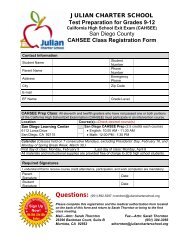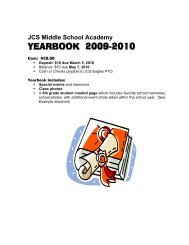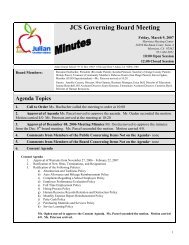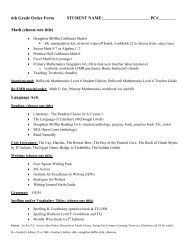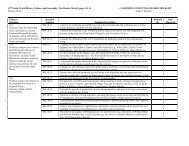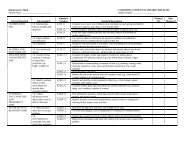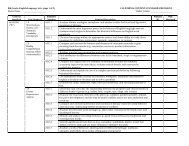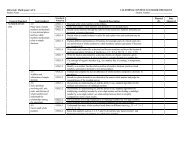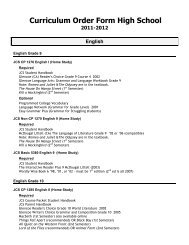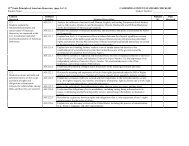2009-2010 Self-Study WASC Action Plan - Julian Charter School
2009-2010 Self-Study WASC Action Plan - Julian Charter School
2009-2010 Self-Study WASC Action Plan - Julian Charter School
Create successful ePaper yourself
Turn your PDF publications into a flip-book with our unique Google optimized e-Paper software.
As indicated on the<br />
chart, the majority of<br />
students, responding,<br />
35.4%, plan on attending<br />
a 4‐year college,<br />
followed equally,<br />
22.6%, by students who<br />
plan to attend a community<br />
college and<br />
those who plan to<br />
attend a community<br />
college and then transfer<br />
to a 4‐year college.<br />
Chart 5: Post‐graduation <strong>Plan</strong>s<br />
What is your goal after high school?<br />
1%<br />
8%<br />
5%<br />
23%<br />
21%<br />
7%<br />
35%<br />
Workforce 1.2%<br />
Community College 22.6%<br />
4‐year College 35.4%<br />
Vocational Training 6.7%<br />
Community College & Transfer<br />
to 4‐year College 21.3%<br />
Military 4.9%<br />
Other 7.9%<br />
91.4% of students responding feel that their educational program is preparing them for<br />
their future and that they are learning the skills needed to be successful. Student<br />
comments include positive indicators “The skills I am learning are actually ones that I<br />
wouldn't acquire in public high school. In public high school, it is more confusing to learn<br />
things because there is limited help from teachers, or they don't teach the concepts in a<br />
way that is easy to understand. When I can learn it on my own, it comes much easier<br />
because I'm teaching myself, and I learn things in a more adult way that prepares me for<br />
college.” There were some indicators that students not planning on attending a 4‐year<br />
college or community college desire more support in the area of career/tech ed.<br />
HOME STUDY STUDENTS<br />
Given the importance of the EF support of students, questions were asked regarding this<br />
relationship and frequency and quality of contact.<br />
45.2% of students indicated that they see their EF weekly, followed by 39.5% who see their<br />
EF at least once a month. This is in alignment with expectations of frequency of student<br />
meetings, which are required once every twenty days, and indicates that EFs are meeting<br />
more frequently with students than the minimum required.<br />
In 2008‐<strong>2009</strong>, 97% of home study students responded that they either strongly agree or<br />
agree that they are satisfied with the relationship they have with their Educational<br />
Facilitator, with 92.5% of students indicating that they feel comfortable contacting their<br />
EF during the month outside of scheduled meeting time. This is an improvement over<br />
previous years’ responses, although the goal is 100%. Steps are being taken to address the<br />
concerns of the 7.5% who were not satisfied. Additionally, 95.1% indicate that their EF<br />
knows them fairly well, very well or extremely well.<br />
Appendix<br />
106 <strong>Julian</strong> <strong>Charter</strong> <strong>School</strong> Focus on Learning <strong>2009</strong>‐<strong>2010</strong>



